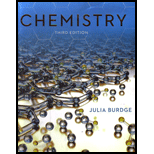
Concept explainers
Commercial silver-plating operations frequently use a solution containing the complex
Interpretation:
The concentration of free
Concept introduction:
When the rate of forward reaction is equal to the backward reaction, a chemical equilibrium is reached.
The general expression of formation constant is represented as follows:
Here,
The relation between molarity and volume is expressed as:
Where
Answer to Problem 77AP
Solution:
Explanation of Solution
The reaction is given as follows:
The expression of
From table 17.5, the value of
Thus,
From the above equation, it is clear that the value of
The initial concentration of
The relation between molarity and volume is expressed as follows:
Substitute
The initial concentration of
The relation between molarity and volume is expressed as follows:
Substitute
The ICE table for the reaction is given as follows:
Substitute
The concentration of free
Want to see more full solutions like this?
Chapter 22 Solutions
Chemistry
- Use the formation constant of [Au(CN)2] in Appendix K to determine the equilibrium concentration of Au+(aq) in a solution that is 0.0071 M CN and 1.1 104 M [Au(CN)2]. Is it reasonable to conclude that 100% of the gold in solution is present as the [Au(CN)2] complex ion? Explain.arrow_forwardAt 25C, 10.24 mg of Cr(OH)2 are dissolved in enough water to make 125 mL of solution. When equilibrium is established, the solution has a pH of 8.49. Estimate Ksp for Cr(OH)2.arrow_forwardSolid Pbl2 (Ksp = 9.8 109) is placed in a beaker of water. After a period of time, the lead(II) concentration is measured and found to be 1.1 103 M. Has the system reached equilibrium? That is, is the solution saturated? If not, will more Pbl2 dissolve?arrow_forward
- Calculate the solubility of copper(II) iodate, Cu(IO3)2 (Ksp = 7.4 108), in (a) water. (b) a 0.10 M copper(II) nitrate solution.arrow_forwardIn the presence of NH3, Cu2+ forms the complex ion Cu(NH3)42+. If the equilibrium concentrations of Cu2+ and Cu(NH3)42+ are 1.8 1017 M and 1.0 103 M, respectively, in a 1.5-M NH3 solution, calculate the value for the overall formation constant of Cu(NH3)42+. Cu2+(aq)+4NH3(aq)Cu(NH3)42+(aq)Koverall=?arrow_forwardCalculate the value of the equilibrium constant, Knet, for dissolving Cu(OH)2 in aqueous ammonia (to form the complex ion [Cu(NH3)4]2+) (Figure 16.9).arrow_forward
 General Chemistry - Standalone book (MindTap Cour...ChemistryISBN:9781305580343Author:Steven D. Gammon, Ebbing, Darrell Ebbing, Steven D., Darrell; Gammon, Darrell Ebbing; Steven D. Gammon, Darrell D.; Gammon, Ebbing; Steven D. Gammon; DarrellPublisher:Cengage Learning
General Chemistry - Standalone book (MindTap Cour...ChemistryISBN:9781305580343Author:Steven D. Gammon, Ebbing, Darrell Ebbing, Steven D., Darrell; Gammon, Darrell Ebbing; Steven D. Gammon, Darrell D.; Gammon, Ebbing; Steven D. Gammon; DarrellPublisher:Cengage Learning Chemistry & Chemical ReactivityChemistryISBN:9781337399074Author:John C. Kotz, Paul M. Treichel, John Townsend, David TreichelPublisher:Cengage Learning
Chemistry & Chemical ReactivityChemistryISBN:9781337399074Author:John C. Kotz, Paul M. Treichel, John Townsend, David TreichelPublisher:Cengage Learning
 Chemistry: An Atoms First ApproachChemistryISBN:9781305079243Author:Steven S. Zumdahl, Susan A. ZumdahlPublisher:Cengage Learning
Chemistry: An Atoms First ApproachChemistryISBN:9781305079243Author:Steven S. Zumdahl, Susan A. ZumdahlPublisher:Cengage Learning ChemistryChemistryISBN:9781305957404Author:Steven S. Zumdahl, Susan A. Zumdahl, Donald J. DeCostePublisher:Cengage Learning
ChemistryChemistryISBN:9781305957404Author:Steven S. Zumdahl, Susan A. Zumdahl, Donald J. DeCostePublisher:Cengage Learning Chemistry by OpenStax (2015-05-04)ChemistryISBN:9781938168390Author:Klaus Theopold, Richard H Langley, Paul Flowers, William R. Robinson, Mark BlaserPublisher:OpenStax
Chemistry by OpenStax (2015-05-04)ChemistryISBN:9781938168390Author:Klaus Theopold, Richard H Langley, Paul Flowers, William R. Robinson, Mark BlaserPublisher:OpenStax





